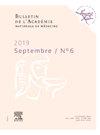De la découverte de la ventilation liquidienne à son application en soins intensifs : un exemple d’interaction entre recherches animale, humaine et technologique
IF 0.3
4区 医学
Q3 MEDICINE, GENERAL & INTERNAL
引用次数: 0
Abstract
Cet article a pour but d’exposer les principaux développements de la recherche sur la ventilation liquidienne. Cette méthode de respiration artificielle consiste à administrer des liquides respirables, les perfluorocarbures, dans les voies aériennes. Leurs propriétés physicochimiques et leur forte solubilité pour l’oxygène et le dioxyde de carbone permettent le maintien d’échanges gazeux. Cette technique a été étudiée dans l’espoir de développer une nouvelle option thérapeutique pour les services de réanimation, en particulier pour le traitement du syndrome de détresse respiratoire aiguë (SDRA) et l’induction d’une hypothermie rapide chez les patients réanimés après un arrêt cardiaque. L’approche la plus étudiée, intitulée « ventilation liquidienne partielle » (VLP), consiste à administrer les perfluorocarbures dans la trachée au cours d’une ventilation mécanique gazeuse traditionnelle. Cette méthode requiert des volumes pulmonaires élevés ayant conduit, lors des expériences cliniques, à l’apparition de volotraumatismes chez certains patients et à l’interruption des recherches sur cette modalité de ventilation. En parallèle, l’intérêt pour l’autre approche de ventilation liquidienne, la ventilation liquidienne totale (VLT), a été renforcé. Cette méthode consiste à échanger un volume courant de liquide à chaque cycle respiratoire à l’aide d’un dispositif dédié. Cela présente l’avantage de contrôler le volume de liquide et de maitriser le risque de volotraumatisme. En revanche, cela nécessite le développement d’une technologie dédiée, ayant soulevé des défis en terme d’ingénierie et de recherche biomédicale. Après une quinzaine d’année de recherche, nous préparons un transfert clinique de cette approche thérapeutique à des fins d’induction d’une hypothermie ultra-rapide après un arrêt cardiaque.
This article aims at presenting the historical background of the research on liquid ventilation. This method of artificial mechanical ventilation consists in the administration of breathable liquids, perfluorocarbons, into the respiratory airways. Their physicochemical properties and high solubility for oxygen and carbon dioxide allow to maintain gas exchanges. Liquid ventilation has been studied as a new therapeutic candidate for intensive care units, particularly for the treatment of acute respiratory distress syndrome (ARDS) and rapid induction of hypothermia in patients resuscitated after cardiac arrest. The most studied approach of liquid ventilation, so-called “partial liquid ventilation” (PLV), consists in the administration of breathable perfluorocarbons into the trachea during traditional gas mechanical ventilation. This method requires high lung volumes, which led, during clinical trials, to the appearance of volotrauma in some patients and to the virtual interruption of the research on PLV. At the same time, interest in another liquid ventilation approach, total liquid ventilation (TLV), has been reinforced. This method consists of exchanging a tidal volume of breathable liquid during each respiratory cycle using a dedicated device. On the one hand, this has the advantage of precisely controlling the volume of liquid into the lung, and therefore controlling the risk of volotrauma. On the other hand, this requires the development of a dedicated device, which has raised challenges in terms of engineering and biomedical research. After around fifteen years of research in the field, we are preparing a clinical transfer of this therapeutic approach for the induction of ultra-rapid hypothermia after cardiac arrest.
求助全文
约1分钟内获得全文
求助全文
来源期刊
CiteScore
0.50
自引率
33.30%
发文量
189
审稿时长
47 days
期刊介绍:
Rédigé par des spécialistes à l''intention d''une Communauté pluridisciplinaire le Bulletin de l''Académie nationale de médecine est au service de toutes les professions médicales : médecins, pharmaciens, biologistes et vétérinaires ainsi que de l''Administration et des institutions intervenant dans le domaine de la santé.
Les mémoires originaux et les mises au point sur des thèmes d''actualité sont associés au compte rendu des discussions qui ont suivi leur présentation. Les rapports des commissions sur l''éthique médicale l''exercice de la profession les questions hospitalières la politique du médicament et l''enseignement de la médecine justifient les recommandations de l''Académie.

 求助内容:
求助内容: 应助结果提醒方式:
应助结果提醒方式:


